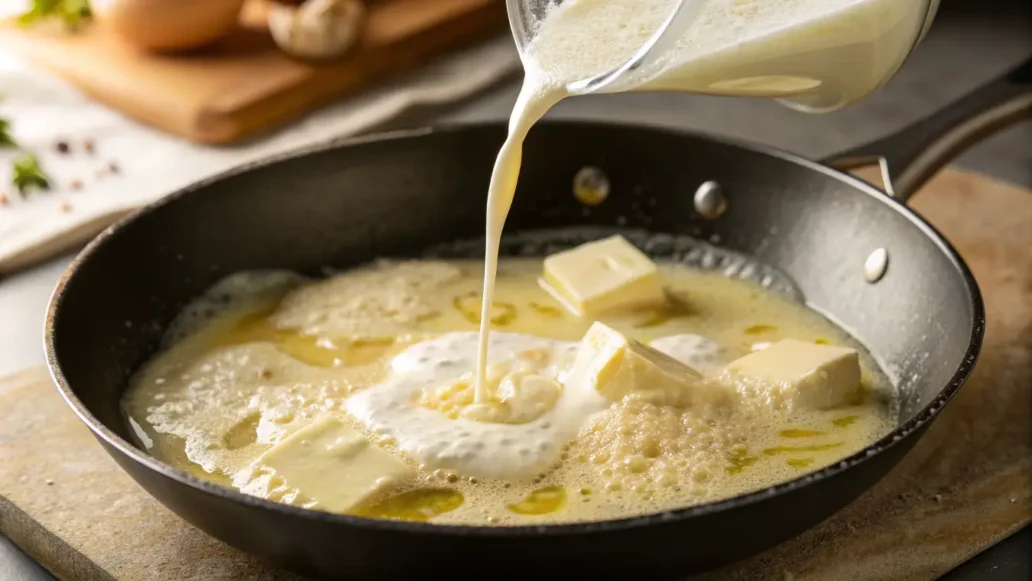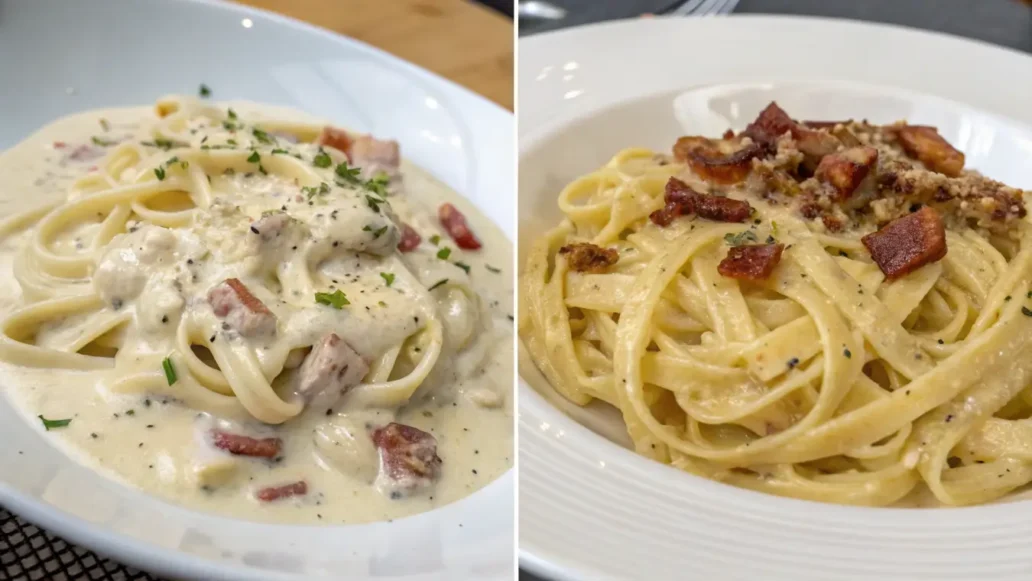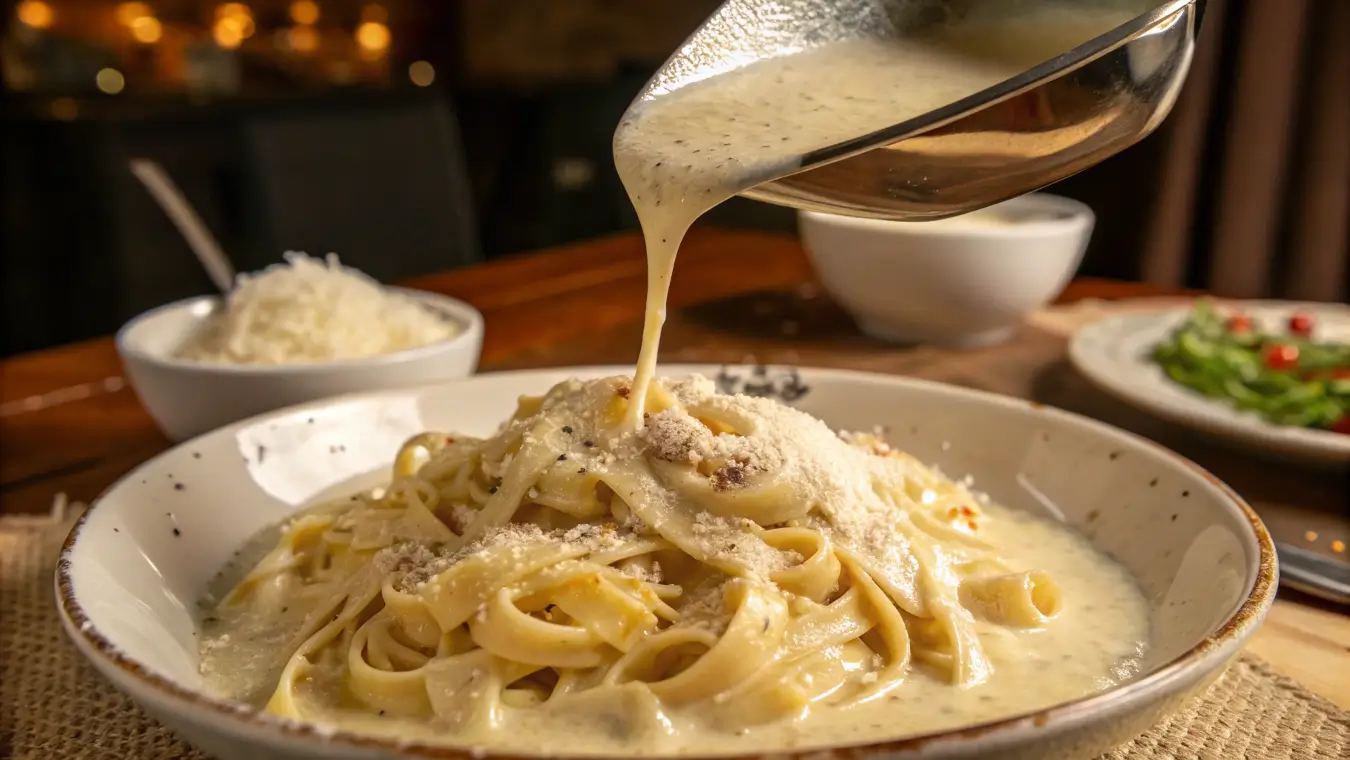Alfredo sauce is one of the most beloved pasta sauces, known for its rich, creamy texture and deep buttery flavor. Whether you’re making classic fettuccine Alfredo, experimenting with flavor variations, or looking for lighter alternatives, this guide will walk you through everything you need to know about Alfredo sauce.
In this article, we will cover:
- The history and origins of Alfredo sauce
- A traditional, authentic Alfredo recipe and how to perfect it
- Ways to make Alfredo sauce even creamier
- How it compares to other pasta sauces like Carbonara
- Pairing ideas and best storage tips
Let’s dive in and master the art of making the perfect Alfredo sauce.
Table of Contents
Introduction to Alfredo Sauce
What is Alfredo Sauce?
Alfredo sauce is a rich and creamy white sauce traditionally made with butter, heavy cream, and Parmesan cheese. It coats pasta beautifully, creating a smooth and decadent dish that has become a favorite in Italian-American cuisine.
Though widely associated with Italian food, the original version of Alfredo sauce was much simpler than what most people know today.
The History of Alfredo Sauce
Alfredo sauce traces its roots back to Rome, Italy, in the early 1900s. It was created by Alfredo di Lelio, a restaurateur who made this dish for his pregnant wife to help with her nausea. The recipe was incredibly simple—just butter and Parmesan cheese tossed with pasta.
The dish gained international fame when Hollywood actors Douglas Fairbanks and Mary Pickford dined at Alfredo’s restaurant in Rome, fell in love with the dish, and spread its popularity in the U.S.
Over time, cream and garlic were added to create the richer, thicker Alfredo sauce commonly found in North America today.
Why is Alfredo Sauce So Popular?
Alfredo sauce remains a favorite for several reasons. It uses simple ingredients made with pantry staples like butter, cream, and cheese. It has a rich and indulgent flavor that is buttery, cheesy, and satisfying. It is quick to prepare, taking only 10-15 minutes to make. It pairs well with many dishes and works with pasta, chicken, seafood, and vegetables.
Whether you prefer the authentic Roman version or the creamy American adaptation, sauce is a must-know recipe for every home cook.
Traditional Alfredo Sauce Recipe

Classic Ingredients for Authentic Alfredo Sauce
A truly authentic Alfredo sauce requires just a few high-quality ingredients. Here’s what you’ll need.
- Butter: Unsalted butter provides a rich base for the sauce
- Heavy cream: Gives Alfredo sauce its signature creamy texture
- Parmesan cheese: Freshly grated for the best flavor and smooth consistency
- Garlic (optional): Adds a depth of flavor to modern Alfredo sauce variations
- Salt and black pepper: Enhances taste and balances the richness
- Nutmeg (optional): A pinch of nutmeg enhances the sauce’s complexity
Step-by-Step Guide to Making Alfredo Sauce
- Melt the Butter – In a pan over medium heat, melt the butter until fully liquefied but not browned.
- Add the Heavy Cream – Slowly pour in the heavy cream, stirring continuously to combine with the butter.
- Simmer the Sauce – Let the mixture simmer for 3-4 minutes, allowing it to thicken slightly.
- Incorporate the Cheese – Add the freshly grated Parmesan cheese gradually, stirring to melt and blend.
- Season the Sauce – Add salt, pepper, and a pinch of nutmeg if desired, then mix until fully incorporated.
- Remove from Heat – Take the pan off the heat once the sauce reaches a smooth, creamy consistency.
Common Mistakes to Avoid When Cooking Alfredo Sauce
- Using pre-grated Parmesan: It contains anti-caking agents that prevent smooth melting. Always use freshly grated cheese.
- Cooking over high heat: High heat can cause the sauce to separate or curdle. Keep it at a gentle simmer.
- Skipping the stirring: Constant stirring prevents the ingredients from separating.
- Adding cheese too quickly: Dumping in all the cheese at once can cause clumping. Gradually add and stir to ensure smooth melting.
A perfectly cooked Alfredo sauce should be velvety smooth, rich, and full of deep buttery flavor. It’s the perfect base for any pasta dish or protein pairing.
How to Make Alfredo Sauce Creamier?
A creamy sauce is the key to a luxurious pasta dish. If your sauce turns out too thin, grainy, or lacks that rich, velvety texture, don’t worry—there are several ways to enhance its creaminess without compromising flavor.
The Secret to a Silky and Rich Alfredo Sauce
- Use High-Quality Ingredients – The better your ingredients, the richer your sauce will be. Use fresh heavy cream, real unsalted butter, and freshly grated Parmesan cheese.
- Simmer, Don’t Boil – Overheating causes cream to separate. Keep the heat at a gentle simmer to help the ingredients meld properly.
- Whisk Constantly – Stirring continuously helps emulsify the fats and prevents the sauce from curdling.
- Add Cheese Slowly – Gradually add Parmesan while stirring to ensure a smooth melt. Dumping it in all at once can lead to clumps.
- Finish with Butter – Adding a small knob of butter at the end of cooking creates a luxurious, glossy finish.
Best Dairy Alternatives for a Lighter Alfredo Sauce
If you’re looking for a lighter Alfredo sauce, there are several substitutions you can use without sacrificing flavor.
| Traditional Ingredient | Lighter Alternative |
|---|---|
| Heavy Cream | Half-and-Half or Whole Milk |
| Butter | Olive Oil or Ghee |
| Parmesan Cheese | Nutritional Yeast or Reduced-Fat Cheese |
You can also try Greek yogurt or coconut milk for a dairy-free yet creamy alternative.
Thickening vs. Thinning: Achieving the Perfect Consistency
If your sauce is too thin, you can thicken it by:
- Adding more Parmesan cheese – The cheese helps bind and thicken the sauce.
- Simmering longer – Allowing the sauce to reduce naturally will make it thicker.
- Using a cornstarch slurry – Mix 1 teaspoon of cornstarch with 2 teaspoons of water and add it gradually while stirring.
If your sauce is too thick, you can thin it by:
- Adding more cream or milk – Stir in a small amount at a time.
- Using reserved pasta water – The starch in the water helps maintain a silky texture.
- Incorporating broth – A splash of chicken or vegetable broth can loosen the sauce while adding flavor.
A well-balanced Alfredo sauce should be smooth, thick enough to coat pasta, but not overly heavy. Experiment with these methods to find your perfect consistency.
Alfredo Sauce Variations & Flavor Enhancements
While traditional Alfredo sauce is a classic, adding different flavors can elevate it into something even more delicious. From garlic-infused to spicy Cajun twists, here are some creative sauce variations to try.
Garlic Parmesan Alfredo Sauce
Garlic enhances the richness of Alfredo sauce with a deep, savory flavor.
How to Make It:
- Add 2-3 cloves of minced garlic to the butter while melting.
- Sauté the garlic for 1-2 minutes until fragrant before adding heavy cream.
- Continue with the classic recipe, and enjoy a bold, garlicky Alfredo sauce.
Perfect Pairings:
- Grilled chicken or shrimp Alfredo
- Garlic bread on the side
- Roasted vegetables like asparagus or mushrooms
Spicy Cajun Alfredo Sauce
A spicy version of Alfredo sauce adds heat and bold Cajun flavors, making it perfect for Southern-inspired dishes.
How to Make It:
- Stir in 1-2 teaspoons of Cajun seasoning while simmering the sauce.
- For extra spice, add a pinch of red pepper flakes or hot sauce.
- Use smoked paprika for a deeper, smoky flavor.
Perfect Pairings:
- Blackened chicken Alfredo
- Spicy shrimp pasta
- Andouille sausage with penne Alfredo
Vegan & Dairy-Free Alfredo Sauce
For a plant-based alternative, replace dairy ingredients with creamy, non-dairy substitutes.
How to Make It:
- Swap butter for olive oil or vegan butter.
- Use unsweetened coconut milk or cashew cream instead of heavy cream.
- Replace Parmesan cheese with nutritional yeast for a cheesy flavor.
- Blend in soaked cashews for a rich, nut-based sauce.
Perfect Pairings:
- Zucchini noodles (zoodles)
- Vegan mushroom Alfredo
- Dairy-free pasta with roasted vegetables
Mushroom & Truffle Alfredo Sauce
Earthy mushrooms and aromatic truffle oil take Alfredo sauce to gourmet levels.
How to Make It:
- Sauté sliced mushrooms in butter before adding heavy cream.
- Stir in truffle oil at the end for a rich, aromatic flavor.
- Garnish with extra Parmesan and fresh parsley.
Perfect Pairings:
- Fettuccine with wild mushrooms
- Truffle Alfredo gnocchi
- Creamy risotto with a hint of truffle
Experimenting with these variations will add excitement to your sauce and create endless new flavor possibilities.
Alfredo Sauce vs. Other Creamy Sauces
Many creamy pasta sauces look similar, but each has distinct ingredients and preparation methods. Let’s compare sauce to Carbonara, Béchamel, and other popular sauces to see how they differ.

Is Alfredo Sauce the Same as Carbonara?
No, Alfredo sauce and Carbonara are not the same. While both are creamy and often paired with pasta, they have different ingredients and preparation methods.
| Feature | Alfredo Sauce | Carbonara Sauce |
|---|---|---|
| Main Ingredients | Butter, heavy cream, Parmesan | Eggs, Pecorino Romano, pancetta |
| Texture | Rich, thick, and creamy | Silky, slightly lighter |
| Cooking Method | Simmered on heat | Made by tossing hot pasta with raw eggs and cheese |
| Protein | Optional (chicken, shrimp) | Pancetta or guanciale |
Alfredo sauce is a cream-based sauce, while Carbonara gets its creaminess from emulsified eggs and cheese.
Differences Between Alfredo, Béchamel, and Mornay Sauce
These three white sauces are often confused, but each has unique characteristics.
| Feature | Alfredo Sauce | Béchamel Sauce | Mornay Sauce |
|---|---|---|---|
| Base Ingredient | Butter and heavy cream | Butter, flour, and milk (a roux) | Béchamel + cheese |
| Thickening Agent | Cream and cheese | Flour-based roux | Cheese |
| Flavor Profile | Rich, buttery, and cheesy | Neutral, creamy, and smooth | More intense cheese flavor |
Béchamel is one of the five mother sauces in French cuisine, while Alfredo is Italian-American. Mornay is simply a cheesier version of Béchamel.
How Does Olive Garden’s Alfredo Sauce Differ?
Olive Garden’s Alfredo sauce is richer and thicker than the traditional Italian version. It includes:
- Heavy cream (instead of just butter and cheese)
- Garlic for added depth
- More Parmesan and Romano cheese for extra thickness
- A longer simmer time to enhance creaminess
If you love Olive Garden’s Alfredo sauce, you can replicate it by using more cream and cheese while simmering longer for a thicker consistency.
Best Dishes to Pair with Alfredo Sauce
Alfredo sauce is incredibly versatile and pairs well with a variety of dishes. Whether you’re making a classic pasta dish or looking for low-carb alternatives, there’s an option for everyone.

Classic Fettuccine Alfredo
Fettuccine Alfredo is the most traditional dish made with this creamy sauce. The wide, flat noodles hold the sauce perfectly, creating a rich and indulgent meal.
How to Make It:
- Cook fettuccine pasta until al dente.
- Toss the pasta with freshly made Alfredo sauce.
- Garnish with extra Parmesan cheese and fresh parsley.
Perfect Pairings:
- Serve with grilled chicken or shrimp for added protein.
- Pair with a side of garlic bread and a crisp Caesar salad.
Chicken Alfredo Pasta
Adding grilled or roasted chicken to Alfredo sauce enhances the dish with a savory, protein-rich element.
Best Chicken Options:
- Grilled Chicken – Adds a smoky, charred flavor.
- Crispy Breaded Chicken – Perfect for Chicken Alfredo Parmesan.
- Shredded Rotisserie Chicken – A quick and easy option for busy nights.
Seafood Alfredo (Shrimp, Lobster, and Crab)
Seafood brings a luxurious twist to Alfredo sauce, adding a delicate sweetness that pairs beautifully with the creamy texture.
Best Seafood Choices:
- Shrimp Alfredo – One of the most popular seafood Alfredo dishes.
- Lobster Alfredo – A decadent upgrade for special occasions.
- Crab Alfredo – Mild and sweet, perfect with linguine.
Cooking Tip:
- Lightly sauté seafood in butter and garlic before adding to Alfredo sauce to enhance its natural flavors.
Low-Carb Alfredo Options (Zoodles, Cauliflower, etc.)
For a healthier take on Alfredo sauce, swap traditional pasta for low-carb alternatives.
| Alternative | Description |
|---|---|
| Zucchini Noodles (Zoodles) | Light and fresh, a great gluten-free option. |
| Spaghetti Squash | Mild in flavor and naturally stringy like pasta. |
| Cauliflower Rice | Works well for Alfredo-based casseroles. |
Alfredo sauce pairs beautifully with these alternatives, making it easier to enjoy a creamy dish without the extra carbs.
PART 7: Storage & Reheating Tips
Alfredo sauce is best enjoyed fresh, but if you have leftovers, proper storage and reheating are key to maintaining its creamy consistency.
How to Properly Store Alfredo Sauce
To keep Alfredo sauce fresh and flavorful, follow these storage tips:
- Refrigerate Immediately – Allow the sauce to cool slightly before transferring it to an airtight container.
- Use Within 3-4 Days – Alfredo sauce should be consumed within a few days for the best taste and texture.
- Avoid Freezing (If Possible) – The high dairy content can cause separation when frozen. However, if you must freeze it, see the freezing instructions below.
Best Methods to Reheat Without Breaking the Sauce
Alfredo sauce can easily separate or turn grainy when reheated incorrectly. Use these methods for the best results:
1. Reheating on the Stovetop (Best Method)
- Heat a small pan over low heat.
- Add a splash of milk or cream to the sauce.
- Stir continuously to bring back its smooth texture.
- Avoid high heat, which can cause the sauce to curdle.
2. Reheating in the Microwave
- Place the Alfredo sauce in a microwave-safe bowl.
- Heat in 15-second intervals, stirring between each to prevent separation.
- Add a little milk if needed to bring back creaminess.
3. Reheating Frozen Alfredo Sauce
If you froze Alfredo sauce, follow these steps to restore its texture:
- Thaw overnight in the refrigerator.
- Heat slowly on the stovetop over low heat.
- Stir continuously, adding a splash of cream or milk to smooth it out.
Can You Freeze Alfredo Sauce?
Yes, but with caution. Freezing Alfredo sauce may cause the cream and butter to separate, leading to a grainy texture when thawed.
How to Freeze Alfredo Sauce Properly:
- Let the sauce cool completely before freezing.
- Store in an airtight container or freezer-safe bag.
- Use within 1-2 months for the best quality.
How to Fix Separated Alfredo Sauce After Freezing:
- Heat slowly and whisk constantly while reheating.
- Add a little butter or milk to help re-emulsify the sauce.
- If needed, use an immersion blender to smooth out any graininess.
Proper storage and reheating techniques will ensure your Alfredo sauce remains as delicious as when it was first made.
Frequently Asked Questions
What is Alfredo sauce made of?
Traditional Alfredo sauce is made with just three ingredients: butter, heavy cream, and Parmesan cheese. Some modern variations also include garlic, salt, pepper, and nutmeg for extra flavor.
How to make a creamy pasta sauce?
To make Alfredo sauce extra creamy, use high-quality heavy cream and real butter. Simmer the sauce gently and whisk continuously to prevent separation. Adding a bit of pasta water can help create a smooth, silky consistency.
Is Alfredo sauce the same as Carbonara?
No, Alfredo sauce is made with butter, cream, and Parmesan, while Carbonara is made with eggs, Pecorino Romano cheese, and pancetta. Carbonara has a silkier texture due to the emulsified eggs, while Alfredo is richer and heavier due to the cream.
What is Olive Garden Alfredo sauce made of?
Olive Garden’s Alfredo sauce includes butter, heavy cream, garlic, Parmesan, and Romano cheese. It is thicker and creamier than traditional Italian Alfredo sauce, which only uses butter and cheese.
Conclusion & Final Thoughts
Alfredo sauce is a timeless and versatile classic that enhances any dish with its rich, creamy texture. Whether you prefer the authentic Roman version with just butter and Parmesan or the American-style creamy Alfredo, mastering this sauce will elevate your home cooking.
Key Takeaways:
- Traditional Alfredo sauce consists of butter, Parmesan, and pasta water, while modern versions use heavy cream for extra richness.
- To achieve the creamiest texture, use freshly grated cheese, low heat, and constant stirring to prevent separation.
- Variations like garlic Parmesan, Cajun Alfredo, and truffle-infused Alfredo can add exciting flavors to the classic sauce.
- Storage and reheating tips are crucial for maintaining the sauce’s consistency—always reheat gently with added milk or cream to restore smoothness.
- Alfredo sauce pairs beautifully with pasta, chicken, seafood, and even low-carb alternatives like zoodles or cauliflower rice.
By following these expert tips and techniques, you’ll be able to create a restaurant-quality Alfredo sauce every time.
